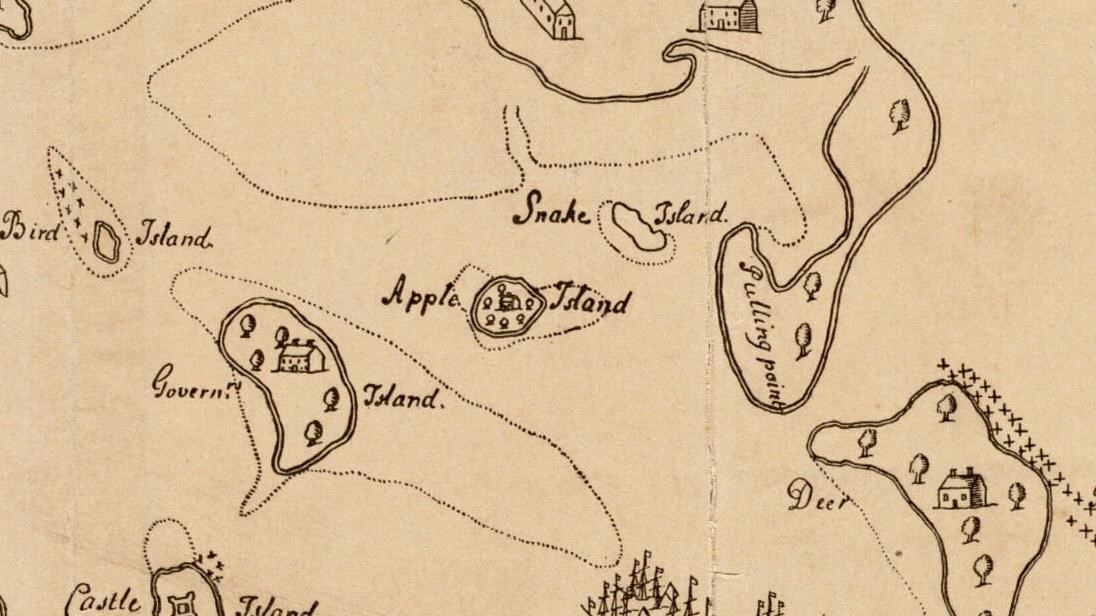Last updated: January 16, 2025
Place
Apple Island

Map courtesy of the Norman B. Leventhal Map & Education Center at the Boston Public Library
Formerly a 10-acre island, Apple Island disappeared when it became absorbed by Boston Logan Airport as part of a runway expansion project in the 1950s.1 Like other islands in the harbor, Indigenous people in the area likely accessed the island seasonally for thousands of years. After European colonization, the town of Boston owned the island and used it for pasturage.2
Thomas Hutchinson, father of the Governor Thomas Hutchinson, became the first "prominent owner" of the island. Likely attracted to the island because of its rich soil and well protected location, he sold the island for $1,000 dollars in 1724. James Mortimer purchased the island in 1760, and continued to use the island for farmland. According to Edward Rowe Snow, a storyteller and historian, Mortimer’s death 13 years later, led to a complicated ordeal. Mortimer’s will stated that when he died, his wife Sarah would receive half of the island’s income, and his brother, Peter would get the other half. A provision in the will stated that should Mortimer’s brother die before his wife, then the island would go to a Peter Mortimer of Connecticut. James Mortimer had not planned for both his wife and his brother to die within the week of his own death. Though confusion ensued, Peter’s widow, Mary Mortimer, took ownership of the island by default.
Snow suspects that during the American Revolution, Continental troops raided the island for sheep and cattle, as they did others in the harbor. William Marsh took control of the island in 1814, eventually purchasing the island from a faraway owner in 1830. Marsh died on the island in 1833.3 The city of Boston purchased the island in 1867. After the Civil War, Colonel Jarvis Dwight Braman established a free Black school in the harbor either on Apple or Rainsford Islands, though it is unknown which island.4
The late 1800s and early 1900s history of Apple Island indicates that a variety of communities used the island. Edward Rowe Snow asserts that a few of the Portuguese fishermen who had been removed from Long Island relocated to Apple Island in the late nineteenth century. Around the turn of the 20th century, illegal boxing matches also occurred on the islands, which caused quite the uproar in nearby areas. Police eventually stopped the matches. King’s Handbook mentions that in the late nineteenth century, people burned vessels on the island for their metals.
The last couple who lived on the island, the Obers, built a small house and spent the summer there in 1932. A gale in November of that year blew the house away and the Obers chose not to rebuild. Not long after, the city flattened the island, and it became a part of Boston Logan Airport.5
Footnotes
-
Olmsted Center for Landscape Preservation, Cultural Landscape Report: Boston Harbor Islands National & State Park, Volume 1: Historical Overview, (Boston: National Park Service, 2017), 15.
-
Moses Foster Sweetser, King’s Handbook of Boston Harbor (Cambridge, MA: Moses King, 1883), 159-160.
-
Sweetser, King’s Handbook of Boston Harbor, 225-26; Edward Snow, The Islands of Boston Harbor (Carlisle, MA: Commonwealth Editions, 2002), 121-126.
-
Sweetser, King’s Handbook of Boston Harbor, 160; Olmsted Center for Landscape Preservation, Cultural Landscape Report Volume 1: Historical Overview, 136.
-
Sweetser, King’s Handbook of Boston Harbor (Cambridge, MA: Moses King, 1883), 118.
-
Snow, The Islands of Boston Harbor, 121-126; Sweetser, King’s Handbook of Boston Harbor, 159-160.
